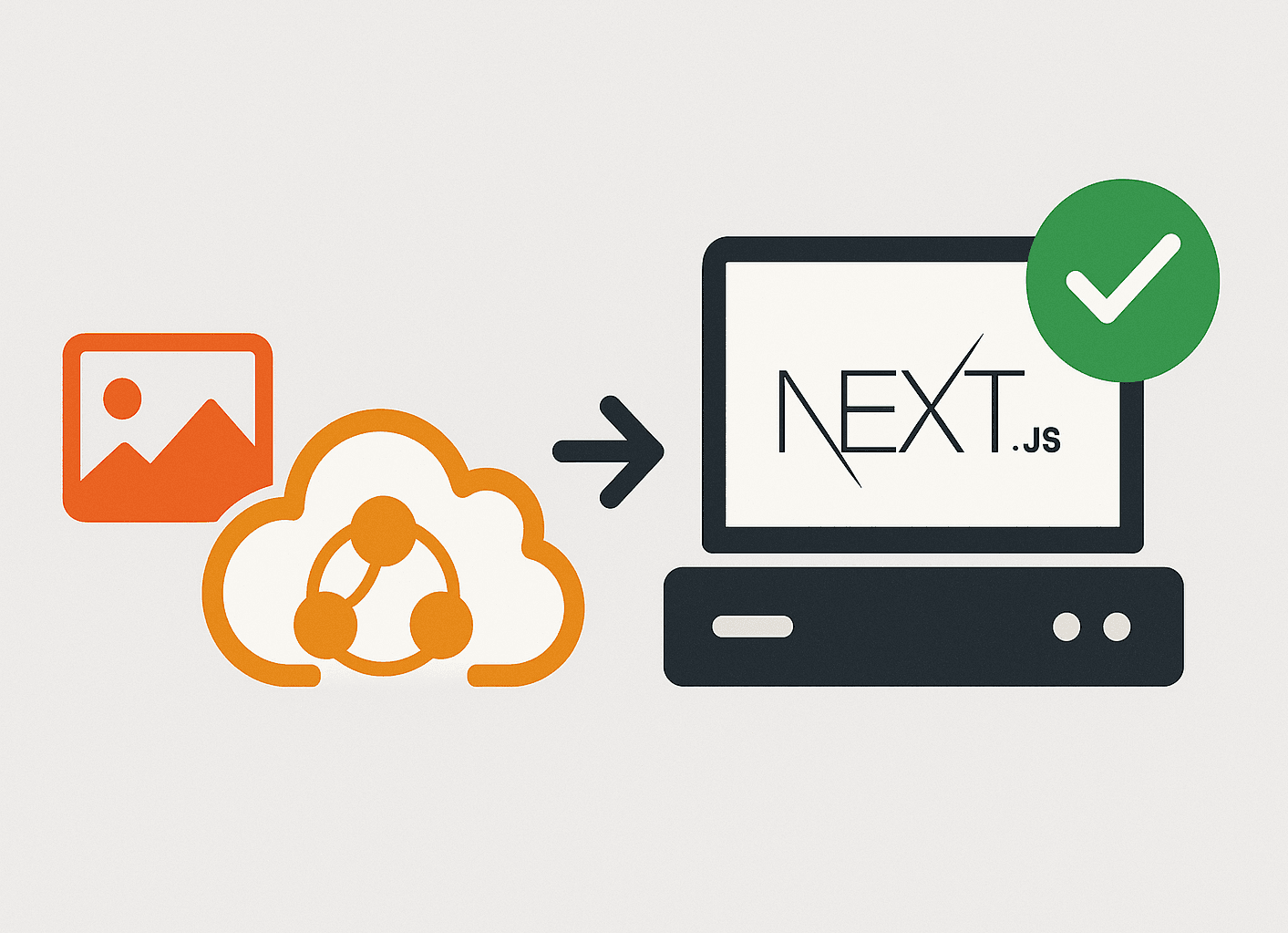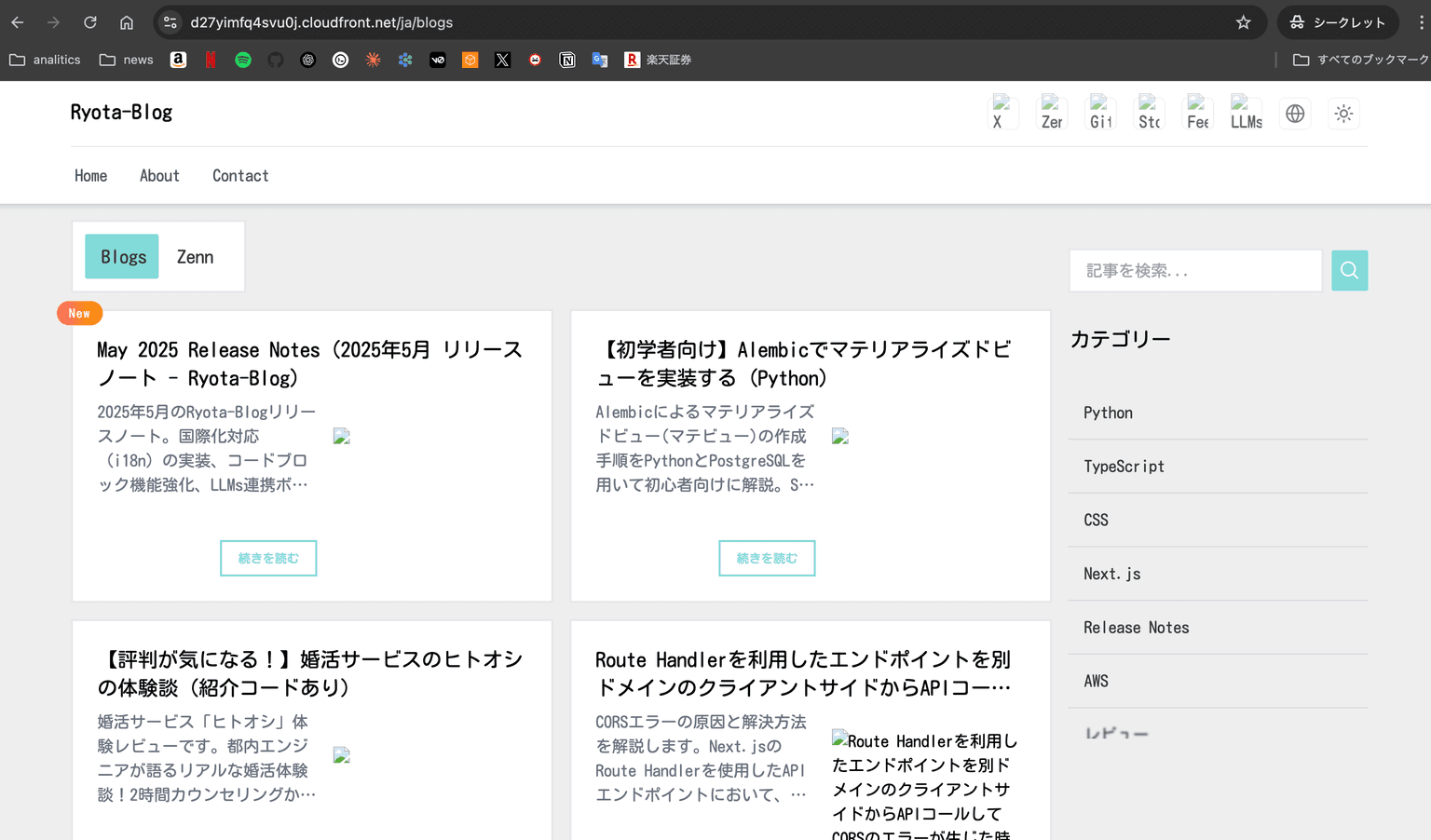Fix CloudFront + Next.js Image Optimization Error: Complete Solution Guide for App Runner

目次
Hello! I'm @Ryo54388667! ☺️
I work as an engineer in Tokyo, primarily dealing with TypeScript and Next.js technologies.
Today, I'll thoroughly explain the image optimization errors that occur when combining CloudFront and Next.js, sharing my journey from encountering the problem to achieving a complete solution!
This article is especially helpful for those struggling with the "url parameter is not allowed" error when accessing staging environments via CloudFront, or those experiencing image display issues with App Runner and CloudFront integration.
Problem Overview 📋
#Symptoms Encountered
#Let me start by detailing the problem I encountered.
Environment Setup
- Backend: AWS App Runner
- CDN: CloudFront
- Framework: Next.js (with image optimization features)
Browser
image 404...😭


Error Details
/_next/image?url=%2Ficons%2Fgithub.webp&w=48&q=75
↓
400 Bad Request: "url" parameter is not allowedHave you seen this error before? 😅 When accessing through a CloudFront domain (xxxxxx.cloudfront.net), the site itself displays correctly, but only the images appear as blank white spaces.
Why Does This Problem Occur?
#Through investigation, I discovered three root causes for this issue:
- Host Header Mismatch Issue
- CloudFront sends requests to App Runner with the Host header still set to the CloudFront domain
- App Runner expects requests with its own domain name, causing routing failures
- Example: CloudFront sends
Host: xxxxxx.cloudfront.netbut App Runner expectsHost: xxxxx.ap-northeast-1.awsapprunner.com
- Query Parameter Forwarding Issues
- Query parameters required for Next.js image optimization (
url,w,q) are not properly forwarded - CloudFront configuration may discard query parameters
- Example: Parameters in
/_next/image?url=%2Ficons%2Fgithub.webp&w=48&q=75don't reach the destination
- Query parameters required for Next.js image optimization (
- Base URL Configuration Conflicts
- Mismatch between
NEXT_PUBLIC_BASE_URLsettings and access domain - This configuration error can trigger circular dependency errors
- Next.js references incorrect base URLs when internally generating image optimization URLs
- Mismatch between
How Next.js Image Optimization Works
#Let me briefly explain Next.js image optimization functionality:
// Next.js Image component usage example
import Image from 'next/image'
export default function MyComponent() {
return (
<Image
src="/icons/github.webp"
alt="GitHub Icon"
width={48}
height={48}
/>
)
}This component actually generates URLs like this:
/_next/image?url=%2Ficons%2Fgithub.webp&w=48&q=75url: Original image path (URL encoded)w: Display widthq: Quality (1-100 value)
This /_next/image endpoint is Next.js's image optimization API, which resizes and optimizes images in real-time. Therefore, if query parameters don't reach this endpoint correctly, images won't display.
Initially, I wondered "Why do only images fail...?" but it's because only the image optimization feature requires special query parameters, while other resources displayed normally.
Trial and Error Process Toward Solution 🔍
#Phase 1: Initial Diagnosis and Basic Fixes
#I first tried reviewing basic configurations.
# Terraform configuration check
terraform plan
terraform apply
# App Runner and CloudFront status verification
aws apprunner describe-service --service-arn xxx
aws cloudfront get-distribution --id xxxAt this stage, I changed NEXT_PUBLIC_BASE_URL to the CloudFront domain, which was a major mistake 😅
// ❌ Incorrect configuration
NEXT_PUBLIC_BASE_URL=https://xxxxxx.cloudfront.net
// This configuration caused circular dependency errorsCircular dependency errors occurred, making the App Runner service itself unstable.
Circular Dependency Error Details:
- Next.js app references the CloudFront domain specified in
NEXT_PUBLIC_BASE_URL - CloudFront forwards that request back to App Runner
- App Runner redirects again to the CloudFront domain
- This repetition creates an infinite loop
At this point, I realized that "basic configuration changes alone won't solve this."
Phase 2: Detailed CloudFront Configuration Adjustments
#Next, I tried making more granular adjustments to CloudFront settings.
# Configuration example attempted
ordered_cache_behavior {
path_pattern = "_next/image*"
allowed_methods = ["GET", "HEAD", "OPTIONS"]
cached_methods = ["GET", "HEAD", "OPTIONS"]
cache_policy_id = "4135ea2d-6df8-44a3-9df3-4b5a84be39ad" # CachingDisabled
origin_request_policy_id = "216adef6-5c7f-47e4-b989-5492eafa07d3" # AllViewer
}This configuration showed temporary improvement, but the AllViewer policy caused compatibility issues with App Runner. Particularly, unexpected behavior occurred with Host Header handling, affecting other endpoints as well.
Specific problems with AllViewer policy:
- Host Header forwarded as CloudFront domain
- App Runner routing triggers CORS errors
- Impact spreads to other API endpoints (
/api/*) - Response times become abnormally long (timeouts occur)
Thinking "Managed policies sometimes have traps..." I decided to try the next approach.
Phase 3: Reverting to Legacy Settings
#Due to managed policy issues, I tried reverting to legacy forwarded_values settings.
# Configuration example attempted
forwarded_values {
query_string = true # Forward all query parameters
headers = ["Origin", "Accept", "Host"]
cookies {
forward = "none"
}
}This configuration made the site display, but the 400 error for images persisted.
At this point, I was convinced that "the cause lies in something more fundamental than configuration issues" and began deeper investigation.
Final Solution Discovery and Implementation 💡
#Root Cause Identification
#Through web research, the following crucial facts emerged:
- CloudFront's
CORS-S3Originpolicy doesn't forward query parameters- Designed for S3, it doesn't support dynamic query parameter forwarding
- Inappropriate for dynamic processing like Next.js image optimization
- App Runner requires its own domain name in Host headers
- App Runner's routing functionality identifies requests based on Host Headers
- CloudFront domain Host headers prevent App Runner from processing correctly
AllViewerExceptHostHeaderpolicy is the solution to this problem- Forwards all request information except Host Header
- CloudFront automatically rewrites Host Header to origin domain
Helpful information sources:
- AWS CloudFront managed policies
- Next.js image optimization with CloudFront best practices
- App Runner Host header requirements
This discovery was the turning point! 🎉
Final Solution Implementation
#1. Adding Data Source
# Adding AllViewerExceptHostHeader policy data source
data "aws_cloudfront_origin_request_policy" "all_except_host" {
name = "Managed-AllViewerExceptHostHeader"
}2. Unifying All Cache Behaviors
# Default cache behavior
default_cache_behavior {
cache_policy_id = "658327ea-f89d-4fab-a63d-7e88639e58f6" # CachingOptimized
origin_request_policy_id = data.aws_cloudfront_origin_request_policy.all_except_host.id
# Other settings...
}
# Image optimization specific behavior
ordered_cache_behavior {
path_pattern = "_next/image*"
cache_policy_id = "4135ea2d-6df8-44a3-9df3-4b5a84be39ad" # CachingDisabled
origin_request_policy_id = data.aws_cloudfront_origin_request_policy.all_except_host.id
# Other settings...
}
# Static assets behavior
ordered_cache_behavior {
path_pattern = "_next/static/*"
cache_policy_id = "658327ea-f89d-4fab-a63d-7e88639e58f6" # CachingOptimized
origin_request_policy_id = data.aws_cloudfront_origin_request_policy.all_except_host.id
# Other settings...
}AWS Managed Policies Used - Detailed Overview 📊
#Here's a summary table of the managed policies used for this solution:
Policy Name | Policy ID | Purpose | Key Points |
|---|---|---|---|
AllViewerExceptHostHeader |
| Auto Host Header rewriting | 🔑 Most critical policy |
CachingDisabled |
| Image optimization (dynamic processing) | For real-time processing |
CachingOptimized |
| Static asset caching | Performance improvement |
Why AllViewerExceptHostHeader Policy is Critical
#The excellent features of this policy include:
- Automatic Host Header Rewriting
- CloudFront automatically changes Host Header to App Runner domain
- Enables App Runner to route correctly
- Example:
Host: xxxxxx.cloudfront.net→Host: xxxxx.ap-northeast-1.awsapprunner.com
- Complete Request Information Forwarding
- Reliably forwards all query parameters (
url,w,q, etc.) - Properly forwards important header information like Accept, User-Agent, Authorization
- Preserves cookies and referrer information
- Reliably forwards all query parameters (
- Configuration Simplicity
- No need for complex
forwarded_valuessettings - No need to specify individual headers or query parameters
- AWS-managed, ensuring future compatibility
- No need for complex
- Performance Optimization
- Reduces overhead by avoiding unnecessary Host Header forwarding
- Speeds up App Runner routing processing
- Improves CDN cache efficiency
Comparison with legacy forwarded_values settings:
# ❌ Legacy complex configuration
forwarded_values {
query_string = true
headers = [
"Authorization",
"Accept",
"Accept-Language",
"Accept-Encoding",
"Origin",
"Referer",
"User-Agent"
# Host needs to be excluded but individual specification is cumbersome
]
cookies {
forward = "all"
}
}
# ✅ Using AllViewerExceptHostHeader policy
origin_request_policy_id = data.aws_cloudfront_origin_request_policy.all_except_host.id
# Done in just one line above!Verification Results and Effects ✅
#Before Fix
#- ❌ Site accessible via CloudFront but images not displayed
- ❌ 400 Bad Request at
/_next/imageendpoint - ❌ Host Header mismatch and query parameter forwarding issues
After Fix
#- ✅ Site completely displays including images via CloudFront
- ✅ Next.js image optimization functions normally
- ✅ Speed improvement due to static asset cache effects
- ✅ Improved configuration reliability through managed policies
When I confirmed the site after the fix, I was truly happy! 🎉
Summary 🎯
#Through solving this CloudFront + Next.js image optimization error, the following key points became clear:
✅ Key Solution Points
#- Introduction of
AllViewerExceptHostHeaderpolicy - Fundamental solution to Host Header issues - Proper cache policy differentiation - Balancing performance and functionality
- Systematic debugging approach - Essential understanding of problem nature
✅ Technical Achievements
#- Complete functionality of Next.js image optimization via CloudFront
- Simplified and reliable configuration through managed policy utilization
- Performance improvements (static asset cache effects)
✅ Future Applications
#- Applicable as knowledge for other Next.js + CDN configurations
- Best practices when using App Runner
- Reference for effective AWS managed policy utilization
While CloudFront and Next.js combinations can become complex in configuration, this demonstrates that proper approaches can definitely solve such issues. I hope this helps others facing similar problems!
If you know better methods or have additional improvement suggestions, please let me know! 🙇♂️
Test Environment: AWS App Runner + CloudFront + Next.js
Resolution Date: 2025-06-21
Result: ✅ Complete functionality of image optimization via CloudFront
Thank you for reading to the end!
I post casually on social media, so feel free to follow! 🥺
